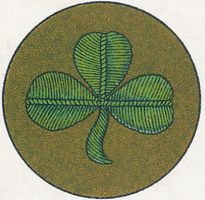
16th (Irish) Division.
16th (Irish) Division was authorised as a second 'New Army' (K2) Division in September 1914.
On formation, the Division was organised as follows:
47th Brigade.
6th Bttn, Royal Irish Regiment.
6th Bttn, Connaught Rangers.
7th Bttn, Leinster Regiment.
8th Bttn, Royal Munster Fusiliers.
48th Brigade.
7th Bttn, Royal Irish Rifles.
9th Bttn, Royal Munster Fusiliers.
8th Bttn, Royal Dublin Fusiliers.
9th Bttn, Royal Dublin Fusiliers.
49th Brigade.
7th Bttn, Royal Inniskilling Fusiliers.
8th Bttn, Royal Inniskilling Fusiliers.
7th Bttn, Royal Irish Fusiliers.
8th Bttn, Royal Irish Fusiliers.
The Division would campaign in the following locations:
Loos Front, December 1915 to August 1916.
The Somme, August 1916 to September 1916.
Guillemont.
Ginchy.
Ypres, June 1917 to August 1917.
Messines.
Langemarck.
Cambrai, November 1917.
German Spring offensive, March 1918 to April 1918.
St Quentin.
Rosieres.
Final Advance in Artois, Autumn 1918.
Due to heavy casualties suffered during the defensive actions against German advances during the spring of 1918,16th (Irish) Division was totally reconstituted and, by July 1918, only one Irish battalion remained in the Division, with the rest having been posted to other formations.
Over the course of the period on the Western Front, there were a number of amendments to the Division's order of battle.
47th Brigade.
6th Bttn, Royal Irish Regiment was disbanded during February 1918 and men redeployed to 2nd and 7th Bttn, Royal Irish Regiment in 49th Brigade.
2nd Bttn, Leinster Regiment joined from 73rd Brigade, 24th Division in February 1918 and, at the same time, absorbing men from 7th Leinster Regiment. It also absorbed troops from the disbanded 6th Connaught Rangers in April 1918 before joining 88th Brigade, 29th Division in the same month.
7th Bttn, Leinster Regiment was disbanded in February 1918 and its men redeployed to 2nd Bttn, Leinster Regiment and 19th Entrenching Battalion.
6th Bttn, Connaught Rangers was reduced to a cadre in April 1918 with most men redeployed to 2nd Bttn, Leinster Regiment during June 1918. The battalion was finally disbanded in August 1918.
1st Bttn, Royal Munster Fusiliers transferred from 48th Brigade in November 1916, absorbing men from the 8th Bttn. It left for 172nd Brigade, 57th (2nd West Lancashire) Division during April 1918 after it had absorbed men from its 2nd Bttn.
8th Bttn, Royal Munster Fusiliers was absorbed by 1st Bttn, Royal Munster Fusiliers during November 1916 when the battalion was disbanded.
48th Brigade.
7th Bttn, Royal Irish Rifles transferred to 49th Brigade during August 1917.
1st Bttn, Royal Munster Fusiliers joined from 86th Brigade, 29th Division in May 1916 before transferring to 47th Brigade during November 1916.
2nd Bttn, Royal Munster Fusiliers joined from 3rd Brigade, 1st Division in February 1918 and, after abosrbing the 19th Entrenching Battalion, was reduced to a cadre in April 1918. It then transferred to 94th Brigade, 31st Division during May 1918 with its surplus men redeployed to the 1st Bttn. In June 1918, the battalion was rebuilt by receiving troops from the disbanded 6th Bttn and in July, it was transferred to 150th Brigade, 50th (Northumbrian) Division.
9th Bttn, Royal Munster Fusiliers was disbanded in May 1916 and men redeployed to its 1st, 2nd, and 8th Bttns.
1st Bttn, Royal Dublin Fusiliers joined in October 1917 from 86th Brigade, 29th Division and amalgamated with the 2nd Bttn in April 1918 before being transferred back to 86th Brigade, 29th Division during the same month.
2nd Bttn Royal Dublin Fusiliers joined from 10th Brigade, 4th Division in November 1916. It was amalgamated with its 1st Bttn in April 1918 with the remaining cadre joining 94th Brigade, 31st Division during June. The battalion was reconstituted by absorbing troops from the 7th Bttn and, after being transferred to Army Reserve in July 1918, it joined 149th Brigade, 50th (Northumbrian) Division.
8th Bttn, Royal Dublin Fusiliers was merged with its 9th Bttn in October 1917. The battalion was disbanded during February 1918 with men being redeployed to its 1st and 2nd Bttns.
10th Bttn, Royal Dublin Fusiliers joined from 190th Brigade, 63rd (Royal Naval) Division in June 1917 and absorbed men from the 8th/9th Bttns in October 1917. It was disbanded during February 1918 with men redeployed to 19th Entrenching Battalion.
5th Bttn, Royal Irish Fusiliers joined from 66th (2nd East Lancashire) Division in August 1918 soon after leaving 31st Brigade, 10th (Irish) Division and immediately absorbed men from its 11th Bttn.
11th Bttn, Royal Irish Fusiliers joined in June 1918 soon after they were formed and absorbed men from the 7th Bttn, Royal Dublin Fusiliers before being absorbed themselves by its 5th Bttn during August 1918.
49th Brigade.
2nd Bttn, Royal Irish Regiment joined from 22nd Brigade, 7th Division in October 1916 and joined 188th Brigade, 63rd (Royal Naval) Division during April 1918.
7th Bttn, Royal Inniskilling Fusiliers was amalgamated with the 8th Bttn in August 1917. It was reduced to a cadre during April 1918 with surplus men redeployed to 2nd Bttn, Royal Irish Regiment. It was transferred to 102nd Brigade, 34th Division in June 1918 before being reestablished and transferred to 89th Brigade, 30th Division the next month.
7th Bttn, Royal Irish Fusiliers was amalgamated with the 8th Bttn in October 1916 before being disbanded during February 1918 with surplus men redeployed to the 1st and 9th Bttns.
7th Bttn, Royal Irish Rifles transferred from 49th Brigade during August 1917 before being transferred to 108th Brigade, 36th (Ulster) Division in October 1917.
7th Bttn, Royal Irish Regiment, which was formed from the dismounted 1st and 2nd South Irish Horse, joined in October 1917. It was reduced to a cadre during April 1918 and, after being reformed, joined 21st Brigade, 30th Division during June 1918.
7th Bttn, Royal Dublin Fusiliers joined as a cadre in June 1918 and were immediately absorbed by 11th Bttn, Royal Irish Fusiliers within 48th Brigade.
By the start of March 1918, the Division was composed of the following units:
47th Brigade.
1st Bttn, Royal Munster Fusiliers.
2nd Bttn, Leinster Regiment.
6th Bttn, Connaught Rangers.
48th Brigade.
1st Bttn, Royal Dublin Fusiliers.
2nd Bttn, Royal Dublin Fusiliers.
2nd Bttn, Royal Munster Fusliers.
49th Brigade.
2nd Bttn, Royal Irish Regiment.
7th/8th Bttn, Royal Inniskilling Fusiliers.
7th Bttn, Royal Irish Regiment.
After suffering very heavy casualties in March/April 1918, the Division returned to England and it was then significantly reconstituted, losing nearly all of its remaining Irish units at this point.
The total number of casualties of 16th (Irish) Division was estimated to total over 28,000 killed, wounded and missing.

